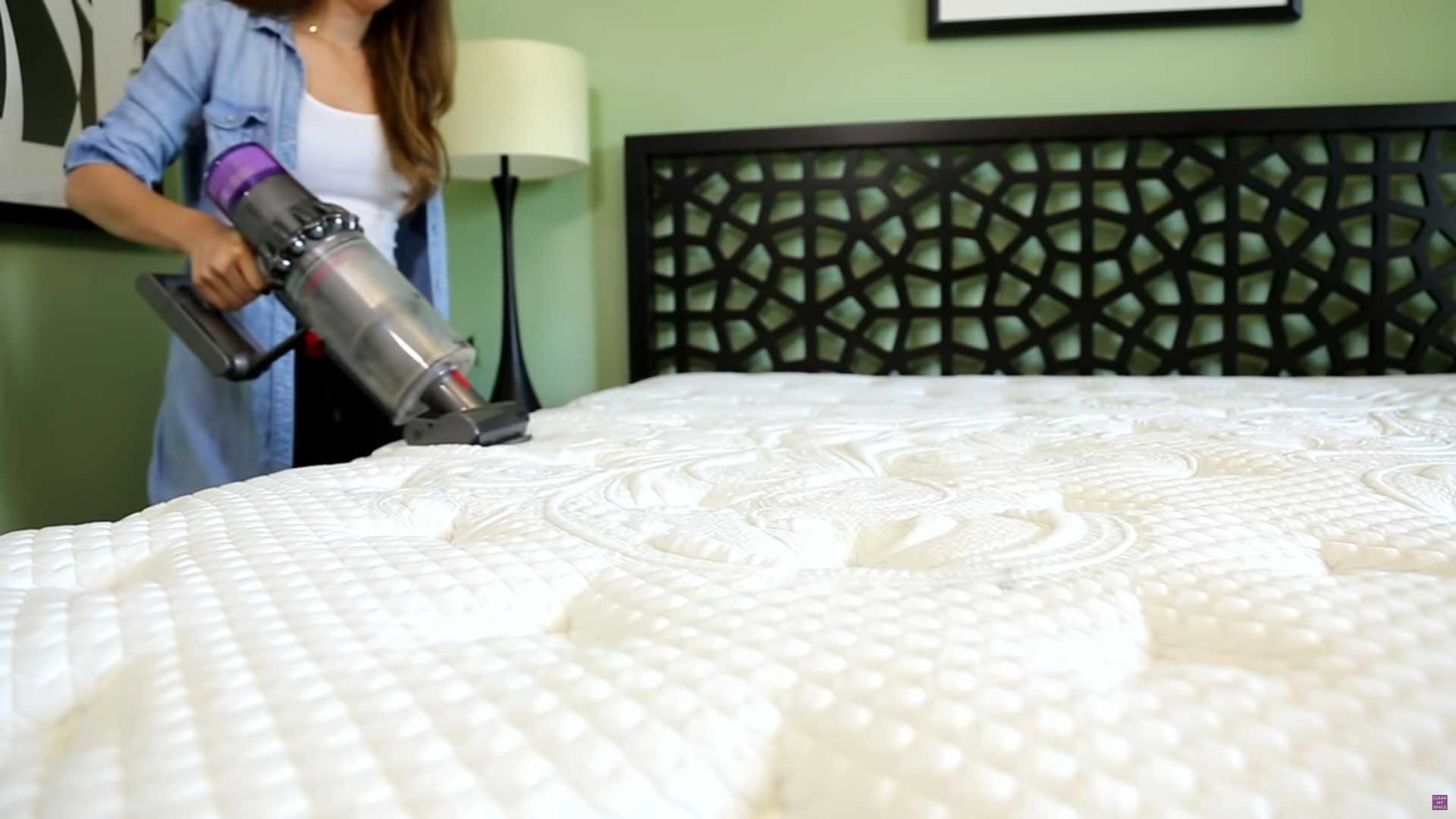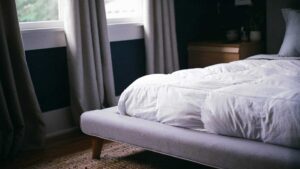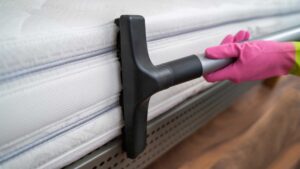Not only is a wet mattress inconvenient, but it also breeds mold and mildew. A wet mattress quickly develops a musty odor, and within a day or two, mold may begin to form deep within it.
Don’t worry, regardless of how your mattress became wet, you can simply dry it with a few simple steps.
Not every soaked mattress can be saved. If the mattress was flooded, the water was most likely contaminated with biohazards, hazardous chemicals, or gasoline. Even if you sanitized the inside of the mattress thoroughly, mold from leftover moisture could infiltrate the mattress undetected.
If you’re looking for a new mattress see our Puffy mattress review.
Tips for Drying Your Mattress
To dry your mattress as fast as possible, use direct sunlight and air movement. Then cover the mattress with a waterproof mattress cover so that you may chuck it in the washing machine the next time it gets wet.
If the mattress is only partially wet from a small spill, there’s a good chance it can be salvaged, as long as you work fast and dry it thoroughly.
Soak up the Moisture With Clean Dry Towels
If a spill or leak occurs, press a clean, dry cloth into the mattress as soon as possible to absorb the liquid. Once your towel is damp, replace it. Attempt to assimilate as much liquid as possible.
Use Kitty Litter or Baking Soda For Big Spills
To help suck most of the residual moisture out of your mattress, try baking soda, kitty litter, or salt. Use whatever you have on hand, however salt is preferred over baking soda or kitty litter.
For larger spills, kitty litter is the best option. Apply one of these chemicals to the affected region, rubbing it in with a toothbrush or pressing it in with your hands. This ensures that the interior layers, not just the surface region, dry fast.
Allow for up to 12 hours of absorption before moving on to the next stage. As the chemical absorbs moisture, it should clump up, indicating that it is working.
To Absorb Excess Fluids Use a Wet/Dry Vacuum
A piece of your mattress may be damp if rain blew in through the window. To suck up the liquid, turn on a wet/dry vacuum and run the nozzle over the damp sections of the mattress in long, even strokes.
You don’t want to touch your mattress with a vacuum nozzle that’s been trapped in spiderweb-filled areas of the garage, so disinfect it first. Simply wipe it inside and out with an antiseptic wipe and let it dry.
Put the Mattress on its Side
Turn the mattress on its side and secure it in position, leaving at least 2 feet of air space on both sides. Place a fan at the end, blowing down both sides, or use two fans, one on each side, aimed straight at the mattress.
To create as much air flow in the space as possible, open windows and switch on ceiling fans, if applicable. A space heater placed at a safe distance from the mattress can also assist speed up the drying process.

Use a Fan, Dehumidifier, or Space Heater
It’s critical to promote optimum air circulation, so make sure the mattress is propped up on the ground with the most surface area visible. It can also be placed on top of saw horses or cinder blocks to expose as much surface area as feasible.
Allow it to dry for up to 24 hours before bringing it inside for the night to avoid further moisture exposure from dew or inclement weather.
Finally, be patient and wait until the mattress is entirely dry before sleeping on or using it. Premature use can stifle the drying process, undoing all of your efforts.
Use Sunlight to Help Dry the Mattress
Sunlight is a natural sanitizer and one of the best ways to completely dry your mattress. If possible, dry and sterilize your mattress outside in the sun.
Place the mattress on its side, lying against the wall and supported by small blocks. It’s critical to allow as much air as possible to circulate through the mattress. A dehumidifier and fans should suffice in instances where the mattress cannot be dried in direct sunshine. It’s best not to use the mattress until it’s entirely dry, as this can lead to mold growth.
When drying a mattress yourself, take extra precautions to sterilize it and ensure that all moisture is removed. After cleaning, keep an eye out for symptoms of mold growth and foul odors.
How to Prevent Mold From Forming on a Wet Mattress
Even if the outside appears to be dry, the inside of the mattress may be damp. Allow it to air dry rather than allowing it to remain damp in the interior. Any moisture can soon turn to mold and mildew, putting your or your family’s health at risk.
Wipe the mattress surface with a solution of half rubbing alcohol and half water to make a mold-inhibiting sanitizing wipe. Avoid soaking the mattress, since this will just make the moisture problem worse.
If you believe the mattress is unsanitary, or if you are unable to dry it and the mattress is extremely costly, another alternative is to hire a professional restoration service. They have the knowledge and skills to thoroughly dry, clean, and sterilize it.
My Mattress Got Wet and Smells
Allergens are kept at bay by freshening and deodorizing mattresses once every six months.
When you apply any type of liquid on your mattress, be careful because it can leave moisture behind, which can encourage allergy growth. Before you make your bed, make sure your mattress is completely dry.
Baking soda is an odor neutralizer that is natural and chemical free. Allow at least 30 minutes for baking soda to absorb into the mattress surface.
The better the outcomes, the longer you store the baking soda. It’s possible to leave it on for up to 24 hours.
To get rid of the baking soda, vacuum your bed with the upholstery attachment.
How to Dry a Mattress With a Hair Dryer
If you spill water on your mattress and the absorbent method didn’t work for you, you can dry it with a towel and your hairdryer.
To absorb the water, press the cloth into the mattress. Then, for ten to twenty minutes, wave your hairdryer over the damp patch. Allow the area to cool before checking for dryness.
The hairdryer produces a direct stream of warm air that can penetrate deeper layers of the skin and remove moisture.
How to Dry a Mattress Without a Hair Dryer
- Use dry towels (cotton or paper) to absorb as much water as you can.
- When the towel becomes too moist replace them.
- Sprinkle kitty litter on the damp spot first, then push down with towels for really moist mattresses. The kitty litter will aid in the removal of additional water and the speeding up of the drying process.
- To remove saturated kitty litter, use a shop vacuum.
- Air dry the remaining moisture.
FAQ
How do you dry a mattress quickly?
Put it out in a space with a lot of natural light and airflow. Start drying it out with a blow dryer after turning on an air conditioner and dehumidifier. This is the quickest and most efficient active method of mattress drying. However, before using the mattress, make sure it is thoroughly dry.
How long does it take to dry a mattress?
How long does a mattress take to dry? Depending on the material and how saturated your mattress is, it could take anywhere from 24 to 48 hours to completely dry after being soaked with water.
What happens if your mattress gets wet?
Water or other liquid spilled and absorbed into the bedding is one of the most damaging things that can happen to a mattress. Mold and mildew thrive in a wet mattress because it gives the ideal setting for them to grow. This can quickly result in scents that extend well beyond the mattress, as well as an unhealthy environment.
How do you dry a mattress at home?
Remove the bedding and clean the dirt. Soak up as much water as you can. Using a Wet-Dry Vacuum, suck up water. Hydrogen peroxide and dish soap can be used to remove stains. Using a hair dryer, dry it. Use a fan and prop up the mattress. It Should Be Moved Outside. Alcohol can be used to disinfect your mattress.
Can you dry a mattress with a hair dryer?
If the absorbent method didn’t work and there’s still moisture on your mattress, you can take a more direct approach and use a hairdryer to dry it. The hairdryer produces a direct stream of warm air that can penetrate deeper layers of the skin and remove moisture.
Can you put baking soda on a wet mattress?
Baking soda is a very easy and effective mattress cleaning agent. Fill your mattress with enough baking soda to cover it in a uniform layer. Allow the baking soda to remain for at least half an hour for moderate scents. The longer you leave it, though, the more moisture and odor-causing particles it absorbs.
How do you dry a wet memory foam mattress?
Allow direct sunlight and fresh air to dry your memory foam mattress if feasible. If staying inside is the only option, situate the mattress near an open window. Place the mattress on its side near an open window to dry completely. An electric fan, on the other hand, could help speed up the drying process indoors.
What happens if a memory foam mattress gets wet?
Memory foam is a porous material that does not absorb liquid like a sponge does. When it gets wet, though, the moisture seeps in and stays there until it is adequately ventilated. A wet mattress is not only uncomfortable, but it also encourages mildew and mold growth.
Can you sleep on a wet mattress?
If the mattress is wet, such as from a roof leak, it’s better to find another place to sleep for the night because it can take up to 24 hours for the mattress to entirely dry. When you cover a wet mattress with sheets and bedding, mold and mildew will grow, which is dangerous to your health.
How can you tell if your mattress has mold?
A strong, musty odor is one of the most typical early indicators of mattress mold. Check if there are new, unexplained stains on the carpet. Other signs of mold include stains that are multicolored, and if insects and parasites are drawn to your mattress. Mold can be found in various parts of your bedroom.



